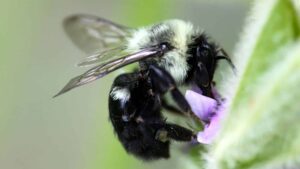Researchers from the University of British Columbia, Université catholique de Louvain (Belgium) and Delft University (The Netherlands) have developed a mathematical model of pollen dispersal by bees, based on field experiments. The study, which was recently published in the Journal of the Royal Society Interface, evaluated the spread of genetically modified organisms to non-modified crops.
“Trying to figure out how far GM pollen will travel is really difficult,” says Rebecca Tyson, University of British Columbia, Okanagan, and study co-author. “It is important to have accurate tools to estimate this, so that unintentional cross-pollination of GM material to non-GM crops can be minimized.”
Tyson says that the simplest way to minimize cross fertilization between crops is to separate them; however, up until now the isolation distances have been somewhat haphazardly determined. Previous estimates have been based on two standard models, which either overestimate or underestimate pollen movement. The gap, Tyson says, between these two distances makes prediction difficult and thus necessitates improved calculations.
From the study, researchers developed a new analytical tool, which can provide a much improved estimate of how far pollen will travel.
“Our results suggest that separation distances of several hundred meteres proposed by some European countries, is unnecessarily large but separation by 40 metres (about 43 yards) is not sufficient,” Tyson says. “Using our model, we can calculate and suggest separation sizes with better accuracy. For example, we have estimated that for a .9 percent cross-pollination rate, the ideal distance of separation between two crops is between 51 and 88 metres (55 and 96 yards), depending on crop size and type.”
These numbers are specific to particular crops and landscapes, Tyson explains, but the predictive ability is the same.
“We believe that our model provides a more accurate assessment of GM pollen cross-pollination than previous models,” she says. “We are hopeful these finding will simplify the decision-making process for crop growers and policymakers.”











